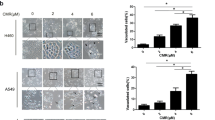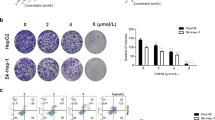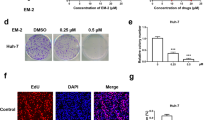Abstract
Chalcomoracin (CMR), a Diels-Alder adduct obtained from mulberry leaves, demonstrated wide-spectrum anti-cancer activity. Herein, we aimed to explore the function of CMR and how it works in hepatocellular carcinoma (HCC). Human HCC cell lines Hep3B and SNU-387 were cultured and treated with various concentrations of CMR (1.5, 3, and 6 µM). Subsequently, the effects of CMR on cell viability, colony formation, apoptosis, migration, and invasion abilities were studied in vitro. Furthermore, the levels of endoplasmic reticulum (ER) stress-related proteins and mitogen-activated protein kinase (MAPK) pathway-related proteins in cells under CMR exposure were detected using western blot. Experiments in vivo were conducted to examine the effects of CMR on tumor growth in HCC. CMR administration inhibited the viability and clonogenic, migration, and invasion abilities, as well as promoted cell apoptosis and ER stress in Hep3B and SNU-387 cells. In addition, CMR treatment reduced the phosphorylation levels of ERK, P38, and JNK in the MAPK pathway. Moreover, an in vivo study showed that CMR administration could inhibit tumorigenesis and MAPK pathway activity in HCC. Our data indicate that CMR has the potential to inhibit the development of HCC, potentially through the inhibition of the MAPK pathway. These findings suggest that CMR may have promising applications as an anticancer agent in future therapeutics for HCC.
This is a preview of subscription content, access via your institution
Access options
Subscribe to this journal
Receive 12 print issues and online access
$259.00 per year
only $21.58 per issue
Buy this article
- Purchase on Springer Link
- Instant access to full article PDF
Prices may be subject to local taxes which are calculated during checkout






Similar content being viewed by others
Data availability
All data generated or analyzed during this study are included in this published article. The datasets used and/or analyzed during the present study are available from the corresponding author on reasonable request.
References
Gilles H, Garbutt T, Landrum J. Hepatocellular carcinoma. Crit Care Nurs Clin North Am. 2022;34:289–301.
Clark T, Maximin S, Meier J, Pokharel S, Bhargava P. Hepatocellular carcinoma: review of epidemiology, screening, imaging diagnosis, response assessment, and treatment. Curr Probl Diagn Radio. 2015;44:479–86.
Hartke J, Johnson M, Ghabril M. The diagnosis and treatment of hepatocellular carcinoma. Semin Diagn Pathol. 2017;34:153–9.
Choi SH, Seong J. Stereotactic body radiotherapy: does it have a role in management of hepatocellular carcinoma? Yonsei Med J. 2018;59:912–22.
Petrowsky H, Fritsch R, Guckenberger M, De Oliveira ML, Dutkowski P, Clavien PA. Modern therapeutic approaches for the treatment of malignant liver tumours. Nat Rev Gastroenterol Hepatol. 2020;17:755–72.
Liao X, Bu Y, Jia Q. Traditional Chinese medicine as supportive care for the management of liver cancer: Past, present, and future. Genes Dis. 2020;7:370–9.
Liu C, Yang S, Wang K, Bao X, Liu Y, Zhou S, Liu H, Qiu Y, Wang T, Yu H. Alkaloids from Traditional Chinese Medicine against hepatocellular carcinoma. Biomed Pharmacother. 2019;120:109543.
Tang KY, Du SL, Wang QL, Zhang YF, Song HY. Traditional Chinese medicine targeting cancer stem cells as an alternative treatment for hepatocellular carcinoma. J Integr Med. 2020;18:196–202.
Liu Y, Zhou X, Zhou D, Jian Y, Jia J, Ge F. Isolation of Chalcomoracin as a Potential α-Glycosidase Inhibitor from Mulberry Leaves and Its Binding Mechanism. Molecules. 2022;27:5742.
Zhang SR, Zhang XC, Liang JF, Fang HM, Huang HX, Zhao YY, Chen XQ, Ma SL. Chalcomoracin inhibits cell proliferation and increases sensitivity to radiotherapy in human non-small cell lung cancer cells via inducing endoplasmic reticulum stress-mediated paraptosis. Acta Pharm Sin. 2020;41:825–34.
Han H, Chou CC, Li R, Liu J, Zhang L, Zhu W, Hu J, Yang B, Tian J. Chalcomoracin is a potent anticancer agent acting through triggering Oxidative stress via a mitophagy- and paraptosis-dependent mechanism. Sci Rep. 2018;8:9566.
Burotto M, Chiou VL, Lee JM, Kohn EC. The MAPK pathway across different malignancies: a new perspective. Cancer. 2014;120:3446–56.
Anjum J, Mitra S, Das R, Alam R, Mojumder A, Emran TB, Islam F, Rauf A, Hossain MJ, Aljohani ASM, et al. A renewed concept on the MAPK signaling pathway in cancers: Polyphenols as a choice of therapeutics. Pharm Res. 2022;184:106398.
Luo H, Vong CT, Chen H, Gao Y, Lyu P, Qiu L, Zhao M, Liu Q, Cheng Z, Zou J, et al. Naturally occurring anti-cancer compounds: shining from Chinese herbal medicine. Chin Med. 2019;14:48.
Wang S, Long S, Deng Z, Wu W. Positive Role of Chinese Herbal Medicine in Cancer Immune Regulation. Am J Chin Med. 2020;48:1577–92.
Zhang X, Qiu H, Li C, Cai P, Qi F. The positive role of traditional Chinese medicine as an adjunctive therapy for cancer. Biosci Trends. 2021;15:283–98.
Han H, Yang Y, Liu B, Tian J, Dong L, Qi H, Zhu W, Wang J, Lei H. Chalcomoracin prevents vitreous-induced activation of AKT and migration of retinal pigment epithelial cells. J Cell Mol Med. 2021;25:9102–11.
Hu X, Yu MH, Yan GR, Wang HY, Hou AJ, Lei C. Isoprenylated phenolic compounds with tyrosinase inhibition from Morus nigra. J Asian Nat Prod Res. 2018;20:488–93.
D’Arcy MS. Cell death: a review of the major forms of apoptosis, necrosis and autophagy. Cell Biol Int. 2019;43:582–92.
Kashyap D, Garg VK, Goel N. Intrinsic and extrinsic pathways of apoptosis: Role in cancer development and prognosis. Adv Protein Chem Struct Biol. 2021;125:73–120.
Pistritto G, Trisciuoglio D, Ceci C, Garufi A, D’Orazi G. Apoptosis as anticancer mechanism: function and dysfunction of its modulators and targeted therapeutic strategies. Aging (Albany NY). 2016;8:603–19.
Kim C, Kim B. Anti-cancer natural products and their bioactive compounds inducing ER stress-mediated apoptosis: a review. Nutrients. 2018;10:1021.
Fernández A, Ordóñez R, Reiter RJ, González-Gallego J, Mauriz JL. Melatonin and endoplasmic reticulum stress: relation to autophagy and apoptosis. J Pineal Res. 2015;59:292–307.
Liu Z, Liu G, Ha DP, Wang J, Xiong M, Lee AS. ER chaperone GRP78/BiP translocates to the nucleus under stress and acts as a transcriptional regulator. Proc Natl Acad Sci USA. 2023;120:e2303448120.
Zhang F, Ni Z, Zhao S, Wang Y, Chang X, Zhou Z. Flurochloridone Induced Cell Apoptosis via ER Stress and eIF2α-ATF4/ATF6-CHOP-Bim/Bax Signaling Pathways in Mouse TM4 Sertoli Cells. Int J Environ Res Public Health. 2022;19:4564.
Rozpedek W, Pytel D, Mucha B, Leszczynska H, Diehl JA, Majsterek I. The Role of the PERK/eIF2α/ATF4/CHOP Signaling Pathway in Tumor Progression During Endoplasmic Reticulum Stress. Curr Mol Med. 2016;16:533–44.
Li J, Zhuo JY, Zhou W, Hong JW, Chen RG, Xie HY, Zhou L, Zheng SS, Jiang DH. Endoplasmic reticulum stress triggers delanzomib-induced apoptosis in HCC cells through the PERK/eIF2α/ATF4/CHOP pathway. Am J Transl Res. 2020;12:2875–89.
Zheng Y, Zhou Q, Zhao C, Li J, Yu Z, Zhu Q. ATP citrate lyase inhibitor triggers endoplasmic reticulum stress to induce hepatocellular carcinoma cell apoptosis via p-eIF2α/ATF4/CHOP axis. J Cell Mol Med. 2021;25:1468–79.
Kim S, Lee M, Song Y, Lee SY, Choi I, Park IS, Kim J, Kim JS, Kim KM, Seo HR. Argininosuccinate synthase 1 suppresses tumor progression through activation of PERK/eIF2α/ATF4/CHOP axis in hepatocellular carcinoma. J Exp Clin Cancer Res. 2021;40:127.
Delire B, Stärkel P. The Ras/MAPK pathway and hepatocarcinoma: pathogenesis and therapeutic implications. Eur J Clin Invest. 2015;45:609–23.
Lee S, Rauch J, Kolch W. Targeting MAPK signaling in cancer: mechanisms of drug resistance and sensitivity. Int J Mol Sci. 2020;21:1102.
Funding
This work was supported by the Science and Technology Program of Fujian Province(Grant No.2020J011159) and Joint Funds for the innovation of science and Technology, Fujian province (Grant No.2021Y9032).
Author information
Authors and Affiliations
Contributions
Yongliang Cui and Liqin Lan designed the study, completed the experiment and supervised the data collection, Jiahui Lv analyzed the data, interpreted the data, Bixing Zhao, Jinfeng Kong and Yongping Lai prepare the manuscript for publication and reviewed the draft of the manuscript. All authors have read and approved the manuscript.
Corresponding authors
Ethics declarations
Conflict of interest
The authors declare no competing interests.
Ethics approval
Ethical approval was obtained from the Ethics Committee of Mengchao Hepatobiliary Hospital of Fujian Medical University (Approval No.MCHH-AEC-2023-07).
Additional information
Publisher’s note Springer Nature remains neutral with regard to jurisdictional claims in published maps and institutional affiliations.
Rights and permissions
Springer Nature or its licensor (e.g. a society or other partner) holds exclusive rights to this article under a publishing agreement with the author(s) or other rightsholder(s); author self-archiving of the accepted manuscript version of this article is solely governed by the terms of such publishing agreement and applicable law.
About this article
Cite this article
Cui, Y., Lan, L., Lv, J. et al. Chalcomoracin promotes apoptosis and endoplasmic reticulum stress in hepatocellular carcinoma cells. J Antibiot (2024). https://doi.org/10.1038/s41429-024-00732-4
Received:
Revised:
Accepted:
Published:
DOI: https://doi.org/10.1038/s41429-024-00732-4



